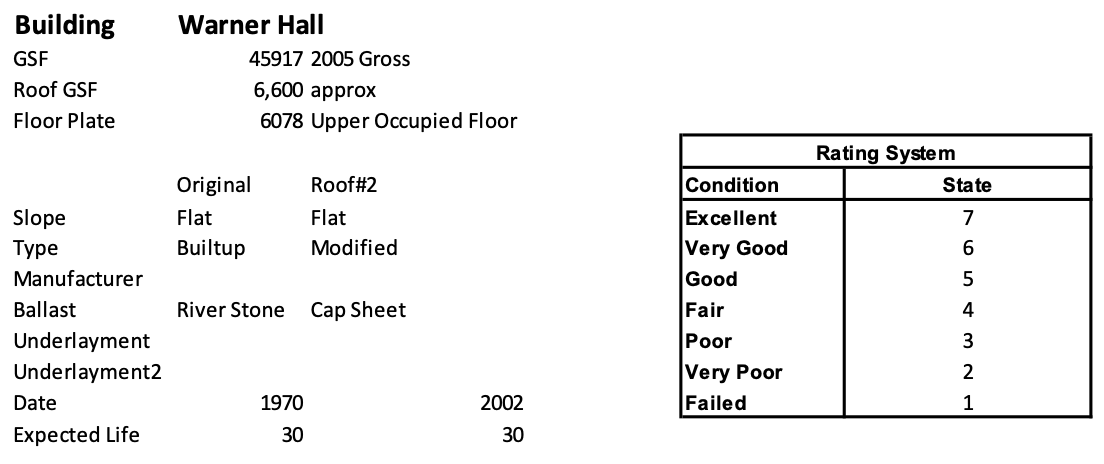2.3: Example Asset Management System- Commercial Roof Management
- Page ID
- 21113
Commercial roofs represent a substantial asset that is often subject to an asset management process. Of course, roofs would only be one component of a building asset management process, but since roofs have special design characteristics, construction and maintenance, they often receive special attention. Figure 2.4 illustrates the various components of a typical low slope commercial roof. A reflective cap for energy conservation is the top layer, with a waterproof membrane, insulation (varying in thickness with design decisions relative to the local climate) and a roof deck below.
 Figure 2.4 - Typical Low Slope Roof Cross Section. Source: Coffelt and Hendrickson, 2010
Figure 2.4 - Typical Low Slope Roof Cross Section. Source: Coffelt and Hendrickson, 2010
The goal of managing commercial roofs is often long term (or life cycle) cost minimization. In addition to roof maintenance and replacement costs, this cost minimization should consider user costs either directly or as a constraint (such as perform maintenance or replace if leaks begin to occur). A direct forecast of user costs would require assessment of the costs associated with roof failures (notably leaks) multiplied by the probability of such failures (Coffelt and Hendrickson 2010 and 2011). Introducing other goals for use of roof space or water retention might motivate adoption of different roof types, such as green roofs with a soil and plant layer (Blackhurst 2010).
Inventory of roofs is based upon building blueprints, maps, and inspection. A database record of a building roof characteristics and records is illustrated in Figure 2.5. The area of the roof is recorded as well as roof characteristics. The location of the roof can be found from the (unique) building name.
In this case, the roof has a record of manual inspections roughly every six months from 1997 to 2005. The inspection rated the condition of the overall roof, the membrane, the roof support and flashing using a five-point rating scale from 1 (new) to 5 (failed). Flashing is a metal strip to prevent water intrusion between a roof and another component such as a vent. In addition to roof inspection and rating, the biannual inspection can be used to perform minor maintenance such as clearing debris on the roof. Note that the roof was generally deteriorating in years 1997 to 2001, and then was in stable condition after the replacement of the old roof.

| Inspection Date | Overall | Support | Membrane | Flashing | Miscellaneous | Asset | Maintenance | Asset Renewal |
|
November 1997 March 1998 November 1998 March 1999 November 1999 March 2000 November 2000 March 2001 March 2002 March 2003 November 2003 March 2004 November 2004 March 2005 November 2005 |
5.50 4.00 4.50 4.00 3.50 2.00 2.50 2.50 6.00 4.50 5.50 5.50 3.50 4.50 4.00 |
6 6 6 6 6 6 6 6 6 6 6 6 6 6 6 |
5 4 4 3 3 2 2 1 6 6 6 6 4 5 6 |
6 4 5 5 4 2 3 4 6 3 5 5 3 4 2 |
6 6 6 6 4 5 5 5 6 6 6 5 6 5 5 |
$
$
$ $ $
$
$
$ |
2,778
836
852 196 194
852
242
1,200 |
95988 |
Figure 2.5 - Illustrative Database of a Commercial Roof Management System. Source: Don Coffelt – Carnegie Mellon University Asset Management System
In any particular year, the roof asset manager would review the roof condition, forecast roof conditions and costs for the next year or so, formulate alternatives (such as replace the roof or perform maintenance as recorded in the data record) and make decisions about treatments to the roof.
Performance monitoring could also be accomplished annually as the roof asset manager evaluates last year’s decisions.
Roof asset management has the advantage of reducing the risk of catastrophic losses that might occur with sudden roof failure. By systematically rating conditions and considering management alternatives, the roof asset manager avoids such failures. Of course, natural hazards such as tornados or hurricanes might still result in roof failures, but even there design decisions such as tying roofs down can reduce the risk of failure.


